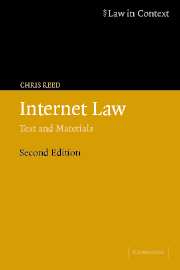Book contents
- Frontmatter
- Contents
- Preface
- Table of UK Statues
- Table of statutes–foreign jurisdictions
- Table of European Communities legislation
- Table of Conventions and Agreements
- Table of cases
- Introduction
- 1 The Internet as a distributed environment
- 2 From each according to his ability : actors and activities in the Internet world
- 3 An infinity of scarce resources : ownership and use of Internet resources
- 4 New actors on a new stage : intermediary liability in the Internet world
- 5 On the Internet, nobody knows you're a dog: identity and identification
- 6 Old wine in new bottles : traditional transactions in the Internet environment
- 7 The long arm of the law : cross-border law and jurisdiction
- 8 Legislative and regulatory arbitrage
- 9 Enforceability in the Internet environment
- 10 Facing the legislative and regulatory challenge
- Index
10 - Facing the legislative and regulatory challenge
Published online by Cambridge University Press: 05 June 2012
- Frontmatter
- Contents
- Preface
- Table of UK Statues
- Table of statutes–foreign jurisdictions
- Table of European Communities legislation
- Table of Conventions and Agreements
- Table of cases
- Introduction
- 1 The Internet as a distributed environment
- 2 From each according to his ability : actors and activities in the Internet world
- 3 An infinity of scarce resources : ownership and use of Internet resources
- 4 New actors on a new stage : intermediary liability in the Internet world
- 5 On the Internet, nobody knows you're a dog: identity and identification
- 6 Old wine in new bottles : traditional transactions in the Internet environment
- 7 The long arm of the law : cross-border law and jurisdiction
- 8 Legislative and regulatory arbitrage
- 9 Enforceability in the Internet environment
- 10 Facing the legislative and regulatory challenge
- Index
Summary
The examination of legal and regulatory issues in the preceding chapters indicates that the challenges posed by the Internet are unlikely to be solved merely by adapting and extending existing legal concepts. The new ways of communicating via the Internet raise legal questions which are fundamentally different for one of two reasons:
The activity is unknown in the physical world, and is so unlike any current type of activity that no existing legal or regulatory model is appropriate. One of the clearest examples of this is the identity certification infrastructure, examined in detail in Chapter 5.
Although the problem is present in the physical world and cannot be solved by extending existing concepts, it occurs so infrequently that leaving it unsolved is an acceptable solution. However, the same problem occurs so frequently in the context of Internet activities that it becomes qualitatively different. Examples of this type of challenge to the law include the domain name/trade mark issues examined in Chapter 3 and the application of indirect taxation rules to on-line supplies of information – see Chapter 8.1.1.1.
If we ask ourselves why these activities present fundamentally new challenges to the law, we see that the challenges arise out of two characteristics which are rarely, if ever, exhibited by traditional physical world activities.
- Type
- Chapter
- Information
- Internet LawText and Materials, pp. 307 - 314Publisher: Cambridge University PressPrint publication year: 2004



